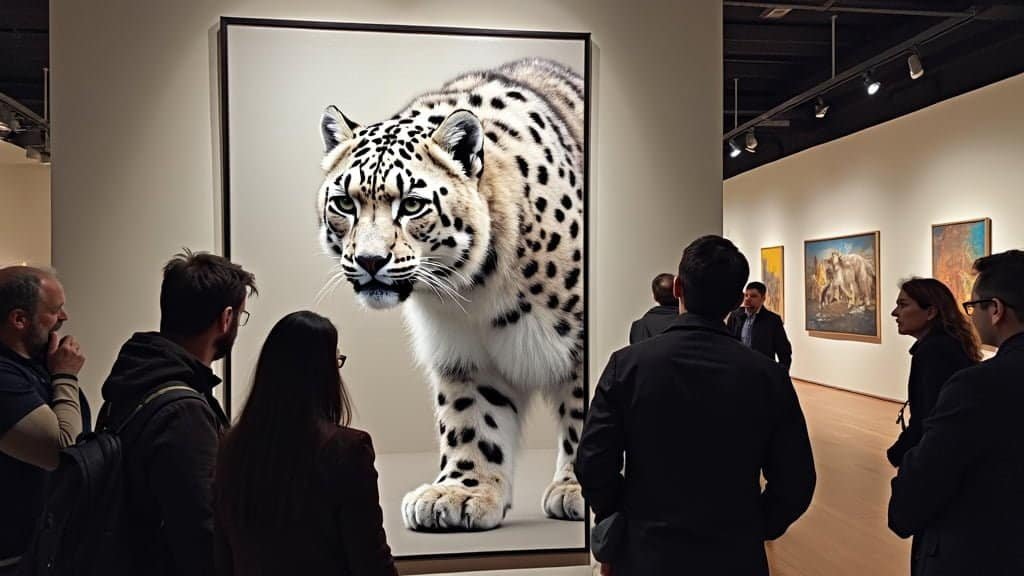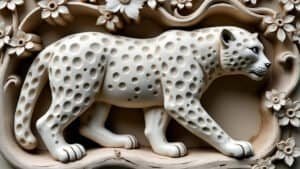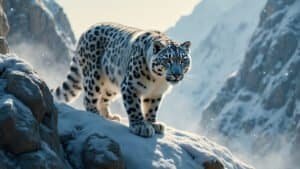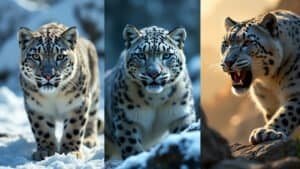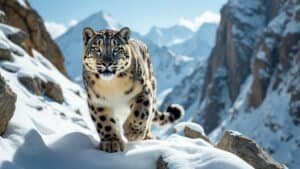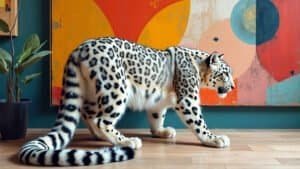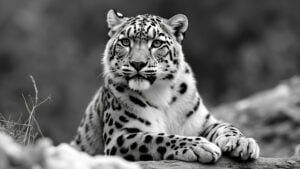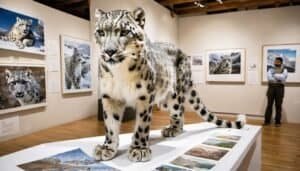Introduction
Snow leopards have long inspired artists across the world, leading to the creation of numerous iconic artworks that celebrate their beauty and mystique. From ancient cultural depictions to contemporary masterpieces, snow leopards have been immortalized in a variety of artistic mediums
This article explores the most famous artworks featuring snow leopards, highlighting traditional paintings, modern interpretations, and captivating wildlife photography. We’ll also delve into digital art, exhibitions, and collections that showcase the enduring appeal of this elusive big cat
Traditional Artworks Featuring Snow Leopards
Snow leopards, known for their elusive nature and striking appearance, have been a subject of fascination for artists across various cultures
Traditional artworks depicting these magnificent creatures often reflect the reverence and mystique associated with them, particularly in regions where snow leopards are native, such as Central and South Asia. These traditional pieces not only showcase the beauty of the snow leopard but also provide insight into the cultural and spiritual significance of the animal
Famous Historical Paintings
Several historical paintings have prominently featured snow leopards, especially in the regions where these animals roam. In Tibetan and Mongolian art, snow leopards often appear as symbols of power and protection
One of the most renowned examples is the thangka paintings from Tibet. These intricate religious paintings, created on cotton or silk, often depict snow leopards alongside deities or as spiritual guardians. The snow leopard’s association with Buddhism, where it symbolizes fearlessness and the overcoming of obstacles, is a recurring theme in these artworks
Another notable example is found in ancient Persian art. The snow leopard, known as “panther” in some Persian texts, was revered for its strength and beauty. It frequently appears in Persian miniature paintings, which are small, detailed illustrations created to complement manuscripts. These miniatures often depict the snow leopard in hunting scenes, reflecting the animal’s status as a symbol of nobility and prowess
Cultural Depictions Across Asia
The depiction of snow leopards in traditional art varies significantly across Asia, reflecting the diverse cultural attitudes toward this enigmatic creature. In China, snow leopards have been featured in various forms of art, from paintings to ceramics
During the Ming and Qing dynasties, snow leopards were sometimes depicted on porcelain ware, symbolizing power and endurance. Chinese artists often portrayed these animals with a sense of grace and serenity, emphasizing their role as a natural marvel within the mountainous landscapes of western China
In India, the snow leopard is not as commonly depicted as other big cats like tigers or lions. However, it appears in some Mughal miniatures, where it is shown as part of royal hunting expeditions. These artworks often emphasize the snow leopard’s elusive nature, illustrating the skill and prestige required to hunt such a rare animal
Influence of Religion and Mythology
Religion and mythology have played a crucial role in shaping the representation of snow leopards in traditional art. In Buddhism, the snow leopard is often seen as a protector, and its image is used in religious rituals and ceremonies
Tibetan Buddhism, in particular, incorporates the snow leopard into its iconography, where it is associated with the Bodhisattva of Compassion, Avalokiteshvara. The snow leopard’s ability to navigate the harsh and rugged terrains of the Himalayas is seen as a metaphor for the spiritual journey toward enlightenment
In Hindu mythology, although the snow leopard does not feature as prominently as in Buddhist traditions, it is sometimes associated with the goddess Durga. Durga, who is often depicted riding a lion or tiger, is a symbol of power and protection
In some regional variants, particularly in the Himalayan regions, the snow leopard replaces the lion, reflecting the local wildlife and cultural context
Modern Artworks Showcasing Snow Leopards
In modern times, the allure of the snow leopard has continued to captivate artists, resulting in a variety of contemporary works that blend traditional motifs with new artistic techniques
These modern interpretations often emphasize the snow leopard’s endangered status, using art as a medium for both aesthetic expression and conservation awareness. From the vivid canvases of 20th-century painters to the dynamic sculptures that capture the animal’s essence, modern art has expanded the ways in which snow leopards are represented and appreciated
Prominent 20th Century Paintings
The 20th century saw a resurgence of interest in wildlife art, with snow leopards becoming a favorite subject for many artists. One notable example is the work of Russian artist Vasily Vereshchagin, who is known for his realistic depictions of Central Asian landscapes and wildlife
His painting “Snow Leopard in the Mountains” (1898) is a prime example of how artists began to portray snow leopards with a heightened sense of realism and detail. This piece, although created at the turn of the century, influenced many subsequent artists who sought to capture the majesty of the snow leopard in its natural habitat
Another influential artist is the British painter George Edward Lodge, a naturalist and illustrator known for his detailed and scientifically accurate wildlife art
Lodge’s paintings of snow leopards, which were often featured in conservation publications, played a significant role in raising awareness about the species. His work is characterized by a deep understanding of animal anatomy and behavior, which he combined with an artist’s eye for composition and color
In the latter half of the century, artists like Robert Bateman, a Canadian painter, brought the snow leopard into the spotlight with his environmental art. Bateman’s “Ghost of the Mountain” (1988) is a hauntingly beautiful portrayal of a snow leopard in a snowy landscape, emphasizing the animal’s elusive and endangered nature
This painting, along with others by Bateman, has been widely exhibited and remains one of the most recognized modern depictions of the snow leopard
Snow Leopards in Contemporary Art
Contemporary artists continue to draw inspiration from the snow leopard, using a variety of styles and mediums to explore its symbolism and beauty. One such artist is Andrew Denman, an American painter known for his hyper-realistic and often surreal wildlife art
Denman’s work often blends elements of abstraction with realism, creating striking images that capture the ethereal quality of the snow leopard. His piece “Snow Leopard Study” (2015) showcases the animal in a stylized, almost dream-like setting, which has been praised for its unique approach to wildlife portraiture
Another contemporary artist, the Chinese painter Cai Guo-Qiang, has incorporated snow leopards into his large-scale works that explore the intersection of nature, culture, and humanity
In his 2014 installation “Heritage,” which featured replicas of various endangered animals, the snow leopard was depicted alongside other creatures as part of a commentary on environmental degradation. Cai’s work often uses gunpowder and other unconventional materials, adding a layer of intensity and urgency to his depictions of wildlife
In the realm of street art, the snow leopard has also found a place. Artists like Sonny Sundancer, known for his large murals that raise awareness about endangered species, have created striking public art pieces featuring snow leopards
Sonny’s murals, characterized by vibrant colors and dynamic compositions, aim to bring attention to the plight of these animals while celebrating their beauty
Iconic Snow Leopard Sculptures
Sculpture, as a medium, has provided artists with a three-dimensional platform to express the power and grace of the snow leopard. One of the most famous snow leopard sculptures is the work of Barry Flanagan, a British sculptor known for his playful yet profound bronze works
Flanagan’s snow leopard sculptures often depict the animal in mid-movement, capturing its agility and strength. These pieces have been exhibited in major galleries and are highly sought after by collectors
In addition to traditional sculpture, modern artists have also experimented with materials to create snow leopard figures. For example, the American artist Deborah Butterfield, known for her sculptures of horses made from driftwood and other found materials, has created snow leopard sculptures that evoke the wild and untamed nature of these animals
Butterfield’s work often blurs the line between representation and abstraction, making her snow leopard sculptures both a homage to the animal and a commentary on the relationship between nature and art
Moreover, the snow leopard has been a popular subject in wildlife bronze sculpture, a genre that has grown in popularity over the past few decades
Artists like Kent Ullberg and Steve Winterburn have created detailed and dynamic bronze sculptures of snow leopards, which are celebrated for their lifelike quality and the sense of movement they convey. These sculptures are often displayed in public spaces or as part of private collections dedicated to wildlife art
Snow Leopards in Wildlife Photography
Wildlife photography has played a significant role in documenting and raising awareness about the elusive snow leopard. The challenge of capturing these secretive animals in their rugged, mountainous habitats has inspired some of the most renowned photographers in the field
These images not only serve as artistic expressions but also as powerful tools for conservation, bringing global attention to the plight of snow leopards in the wild
Celebrated Wildlife Photographers
Several photographers have gained recognition for their extraordinary images of snow leopards, often dedicating years to tracking and capturing the perfect shot. One of the most celebrated among them is Steve Winter, an award-winning National Geographic photographer
Winter’s work on snow leopards, particularly his 2008 series, has become iconic. He spent months in the Himalayas using remote camera traps to capture these elusive cats, resulting in some of the most intimate and revealing images of snow leopards ever taken. His photograph of a snow leopard in the Indian Himalayas, framed against a stark winter landscape, remains one of the most famous wildlife images in recent history
Another notable photographer is Vincent Munier, a French wildlife photographer known for his ethereal images of Arctic and mountainous wildlife. Munier’s approach to photographing snow leopards is characterized by patience and a deep respect for nature
His book “Himalaya, Land of the Snow Leopard” (2015) features stunning black-and-white photographs that convey the solitude and majesty of the snow leopard’s habitat. Munier’s work is highly regarded not only for its artistic quality but also for its contribution to conservation efforts
David Yarrow, a British photographer renowned for his fine art wildlife photography, has also made significant contributions to the portrayal of snow leopards
Yarrow’s dramatic, high-contrast images often depict snow leopards in a way that emphasizes their strength and resilience in harsh environments. His work is celebrated for its striking composition and the emotional impact it delivers, making it a favorite among collectors and conservationists alike
Award-Winning Snow Leopard Photos
Over the years, numerous photographs of snow leopards have been recognized in prestigious wildlife photography competitions, helping to raise awareness about the species. The Wildlife Photographer of the Year competition, one of the most respected in the field, has featured several award-winning images of snow leopards
For instance, in 2017, a photograph titled “The Ghost Cat” by photographer Frédéric Larrey won in the category of Animals in Their Environment. This haunting image, showing a snow leopard navigating a snowy cliff, was praised for its composition and the difficulty of capturing such a moment
Similarly, the Big Picture Natural World Photography Competition has honored several snow leopard photographs that highlight the animal’s interaction with its environment. These images often capture the delicate balance between the snow leopard and its rugged, often unforgiving, habitat, providing a visual narrative of survival and adaptation
Photographs from these competitions not only bring artistic acclaim to the photographers but also serve as important tools in the conservation of snow leopards. The widespread publication and exhibition of these images help to educate the public and generate support for initiatives aimed at protecting the species and its habitat
Influence of Conservation Efforts
Conservation organizations have increasingly turned to photography as a means to engage the public and garner support for their efforts to protect snow leopards
Organizations like the Snow Leopard Trust and Panthera have collaborated with wildlife photographers to create compelling visual campaigns. These collaborations often result in stunning imagery that is used in fundraising, education, and awareness initiatives
For example, the Snow Leopard Trust’s partnership with photographers like Steve Winter has been instrumental in raising awareness about the threats facing snow leopards, such as habitat loss and poaching. These photographs, often featured in campaigns and reports, help to humanize the conservation message, making the plight of snow leopards more relatable to a global audience
The use of camera traps, which are motion-activated cameras placed in the wild, has revolutionized how snow leopards are photographed and studied
Camera trap photography provides researchers with invaluable data about snow leopard populations, behaviors, and movements. Some of the most striking images captured by camera traps have been widely published, showing snow leopards in candid moments that would be nearly impossible to capture otherwise. These images play a crucial role in conservation science, helping to inform strategies for protecting these endangered animals
Additionally, exhibitions featuring snow leopard photography have become popular events in the art and conservation communities
These exhibitions often travel internationally, bringing the beauty and plight of the snow leopard to audiences around the world. The combination of art and science in these exhibitions underscores the importance of visual storytelling in conservation
Digital Art and Illustrations of Snow Leopards
With the rise of digital media, artists have found new ways to capture the beauty and mystique of snow leopards. Digital art and illustrations allow for a wide range of creative expression, blending realism with fantasy to create visually striking images of these elusive creatures
The flexibility of digital tools has enabled artists to experiment with colors, textures, and forms, resulting in a diverse array of artwork that continues to draw attention to snow leopards in the digital age
Popular Digital Artists
Several digital artists have gained recognition for their unique portrayals of snow leopards, using a variety of techniques and styles to bring these animals to life on screen. One such artist is Aaron Blaise, a former Disney animator known for his wildlife-themed digital art
Blaise’s snow leopard illustrations are characterized by their detailed rendering and expressive use of light and shadow. His work often emphasizes the majestic and mysterious qualities of the snow leopard, creating images that resonate with both art lovers and wildlife enthusiasts
Another prominent digital artist is Kerem Beyit, a Turkish illustrator whose fantasy-inspired works often feature powerful and mythical creatures, including snow leopards
Beyit’s art blends hyper-realistic details with imaginative elements, creating dynamic compositions that capture the strength and elegance of snow leopards. His work is widely admired for its intricate detailing and dramatic visual style, making it a favorite among fans of fantasy art
In addition, artists like Joel Sartore, who is also a renowned wildlife photographer, have expanded their creative reach into the digital realm. Sartore’s digital portraits of snow leopards combine photography with digital enhancements, producing images that highlight the animal’s beauty while also conveying a sense of urgency about its endangered status
His work is part of larger conservation efforts, such as the National Geographic Photo Ark project, which aims to document and preserve species at risk of extinction
Techniques in Digital Snow Leopard Art
Digital art allows for a wide range of techniques that can be used to depict snow leopards in innovative ways. One common approach is the use of digital painting, where artists create their works from scratch using software like Adobe Photoshop, Corel Painter, or Procreate
This technique enables artists to experiment with brush strokes, color palettes, and textures that mimic traditional painting while offering the flexibility of digital tools. Artists can easily make adjustments, layer elements, and add intricate details, resulting in highly polished and lifelike images
Another technique involves the use of photomanipulation, where artists blend photographic elements with digital painting to create composite images. This method is often used to place snow leopards in fantastical or surreal environments, combining realism with imaginative storytelling
By manipulating photographs and incorporating digital effects, artists can create scenes that range from hyper-realistic to entirely fantastical, offering new perspectives on the snow leopard’s role in art and culture
Vector art is another popular technique in digital illustration, where artists use software like Adobe Illustrator to create clean, scalable images of snow leopards. This style is often more stylized and graphic, focusing on bold lines, shapes, and colors
Vector illustrations of snow leopards are frequently used in branding, merchandise, and educational materials, thanks to their versatility and modern aesthetic
Moreover, digital artists often experiment with mixed media techniques, combining traditional hand-drawn elements with digital enhancements. This hybrid approach allows artists to maintain the tactile quality of traditional art while taking advantage of digital tools to refine and elevate their work. The result is a rich, textured image that reflects the artist’s individual style and the unique qualities of the snow leopard
Snow Leopards in Graphic Design and Media
Snow leopards have also become a popular motif in graphic design, where their distinctive features and symbolic meanings are leveraged in various media. In branding, snow leopards are often used to convey qualities such as strength, elegance, and exclusivity
For example, luxury brands may incorporate snow leopard imagery into their logos or marketing materials to evoke a sense of sophistication and rarity
In addition to commercial uses, snow leopards are frequently featured in educational and conservation-focused graphic design. Infographics, posters, and digital campaigns often use stylized illustrations of snow leopards to draw attention to environmental issues and conservation efforts
These designs aim to engage the public by combining striking visuals with informative content, making complex issues more accessible and compelling
The presence of snow leopards in digital media extends to video games, animation, and virtual reality experiences as well. In video games, snow leopards are often depicted as powerful creatures, either as part of the natural landscape or as mythical beings with special abilities
Animation studios have also embraced snow leopards as characters in films and television shows, where their grace and agility are highlighted through fluid, lifelike movement
Furthermore, virtual reality (VR) and augmented reality (AR) platforms have begun to explore snow leopard-themed experiences, allowing users to interact with digital versions of these animals in immersive environments. These experiences often serve educational purposes, offering users a chance to learn about snow leopards and their habitats in an engaging, interactive format
Exhibitions and Collections Featuring Snow Leopards
Exhibitions and art collections dedicated to snow leopards offer a unique opportunity to explore the diverse ways artists have depicted these magnificent animals
From museum displays to private collections and traveling shows, snow leopard-themed exhibitions serve as important platforms for education, conservation, and appreciation of art
These exhibitions not only highlight the beauty of snow leopards but also draw attention to the urgent need to protect them and their habitats
Major Exhibitions Focused on Snow Leopards
Several major exhibitions have been organized around the theme of snow leopards, often in collaboration with conservation organizations and wildlife foundations. One of the most notable exhibitions is the “Ghost of the Mountains” series, which has been featured in museums and galleries around the world
This exhibition, curated by the Snow Leopard Trust, showcases a variety of artworks, including paintings, photographs, and sculptures, all centered on the elusive snow leopard. The exhibition aims to raise awareness about the species’ endangered status and to inspire action toward their conservation
Another significant exhibition is “Snow Leopards: Guardians of the Himalayas,” which has been held at various natural history museums and cultural institutions. This exhibition combines art with science, presenting both artistic interpretations and scientific information about snow leopards and their habitats
Visitors can view a range of artworks, from traditional thangka paintings to modern digital art, alongside interactive displays that provide insights into the snow leopard’s behavior, ecology, and conservation challenges
In addition, “Art for Conservation” exhibitions, often hosted by wildlife conservation organizations, frequently feature snow leopards as part of a broader focus on endangered species
These exhibitions typically include a diverse range of artistic mediums, with proceeds from sales supporting conservation initiatives. Such exhibitions play a crucial role in linking art with activism, demonstrating how creative expression can contribute to environmental awareness and action
Famous Museums and Collections
Snow leopards have found a place in some of the world’s most famous museums and private art collections. The British Museum, for example, houses several historical pieces featuring snow leopards, particularly in its collections of Asian art
These works often reflect the cultural significance of snow leopards in regions like Tibet, Mongolia, and Persia, showcasing the animal’s role in traditional religious and mythological contexts
The Metropolitan Museum of Art in New York also includes snow leopard-themed art in its collection of Himalayan and Central Asian artifacts
Visitors can find intricately designed thangkas, statues, and textiles depicting snow leopards, often in religious or ceremonial contexts. These pieces offer a glimpse into how snow leopards have been revered and symbolized throughout history, particularly in Buddhist and Hindu traditions
In addition to public museums, private collections of wildlife art often feature prominent works depicting snow leopards. Collectors with a passion for both art and conservation frequently seek out pieces that highlight the beauty and importance of these animals
For instance, the collection of the late American philanthropist Robert W. Wilson, known for his support of environmental causes, included several significant snow leopard artworks, reflecting his commitment to conservation
Thematic Snow Leopard Art Shows
Thematic art shows dedicated exclusively to snow leopards have become increasingly popular, particularly in regions where these animals are native
These shows often serve as fundraising events for conservation efforts, bringing together artists, conservationists, and the public in support of a common cause. One such event is the annual “Snow Leopard Day” art show, held in countries like India and Mongolia, where snow leopards are a key part of the cultural and natural heritage
These art shows typically feature a range of works, from traditional paintings and sculptures to contemporary digital art and photography. The focus is not only on celebrating the beauty of snow leopards but also on raising awareness about the threats they face
Proceeds from the sale of artworks often go directly to organizations working to protect snow leopards and their habitats, making these shows a vital part of global conservation efforts
In addition to physical exhibitions, online platforms have also emerged as important venues for snow leopard-themed art shows. Virtual galleries and auctions allow artists from around the world to showcase their work, reaching a global audience and generating support for conservation causes
These online events have become particularly important in recent years, providing a platform for artists and conservationists to collaborate and raise funds despite geographical barriers
Conclusion
Snow leopards have captivated artists for centuries, inspiring a rich body of work that spans traditional paintings, modern art, wildlife photography, and digital illustrations. These artworks not only celebrate the snow leopard’s beauty and mystique but also play a crucial role in raising awareness about its endangered status
From ancient cultural depictions to contemporary exhibitions, snow leopards continue to be a powerful symbol in the art world, reflecting both their elusive nature and the urgent need for conservation. Through these diverse artistic expressions, the snow leopard remains an enduring icon, reminding us of the delicate balance between humanity and the natural world
